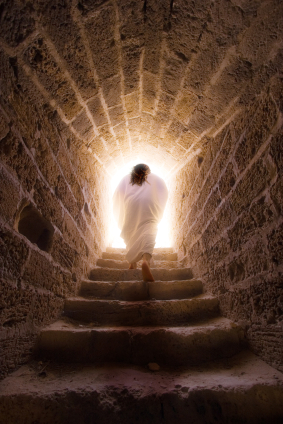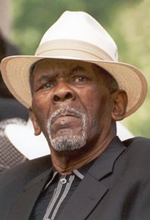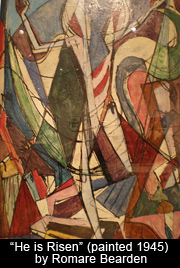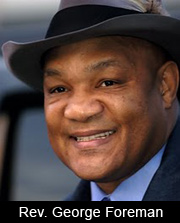Cultural Resources

Jesus walks out of the tomb.
EASTER
CULTURAL RESOURCES
Sunday, April 4, 2010
Allen Dwight Callahan, Guest Cultural Resource Commentator
Independent Scholar residing in Roxbury, MA
Scripture: John 11:25
I. The History Section
Our lectionary commentator has ably addressed in a fashion relevant for use today the story of our text which features Jesus, Lazarus, Martha and Mary. So, I want to offer other information relevant to our 2010 theme for Easter which is resurrection by talking about the faith of a woman who was one of the first to proclaim the resurrection.
She is Mary but is called Magdalene because she hails from Magdala, a hamlet on the Sea of Galilee between Capernaum and Tiberias, and known to Matthew as Magadan (Mt. 15:39) and to Mark as Dalmanutha (Mk. 8:10). The town’s Semitic name survived down to modern times as Al-Megdel, an Arab village bulldozed out of existence by the Israelis in 1948.1 Jesus was a denizen of the small rural jerkwaters and rude little fishing villages (Nazareth, Cana, Capernaum, and Tiberias) which lay in the northern frontier of the ancestral Israelite territory called Galilee. A mere five kilometers north of Tiberias lay Magdala – Mary’s hometown. Mary, too, was a Galilean. She was the girl next door.
Mary Magdalene had come from the same neck of the woods as Jesus, the same side of the tracks. Now, she comes to the garden alone. The text tells us that Mary was standing at the tomb weeping. Tears are the spectrum that refracts the Gospel’s vision of life over death. At another tomb earlier in the story we have already seen the powerful alchemy of a woman’s tears. So, too, tears fall on the first Easter’s eve.
In the other three Gospels, women are the first to learn of the resurrection of Jesus. There is no epiphany. And there are no tears. Here in the Gospel of John, and only here, in the garden, the tears of one kneeling, anguished woman summon the presence of the risen Lord. Mary’s comfort cannot be delegated to angels. This woman’s tears demand that Jesus deal with this crisis of mortality in the garden as he had dealt with that of Lazarus – in person.
II. Songs that Speak to the Moment
Mary comes to the garden before dawn, “while the dew is still on the roses.” Though not a hymn of Eastertide, the first strophe of C. Austin Miles’ “In the Garden” could read as a devotional commentary on the biblical account of Mary’s encounter with Jesus that first Easter morn.
In the Garden
I come to the garden alone,
While the dew is still on the roses,
And the voice I hear falling on my ear,
The Son of God discloses . . .
And he tells me I am his own,
And the joy we share as we tarry there,
None other, has ever, known!
He speaks and the sound of his voice,
Is so sweet the birds hush their singing,
And the melody that he gave to me,
Within my heart is ringing . . .
And he walks with me, and he talks with me,
And he tells me I am his own,
And the joy we share as we tarry there,
None other, has ever, known!
None other, has ever, know. 2
Mary’s zeal and grief are a recurring theme in the Negro spirituals. She appears in flight in the song “He Arose”:
He Arose
Sister Mary, she came running, a-looking for my Lord
Sister Mary, she came running, a-looking for my Lord
And the Lord will bear my spirit home.
He ‘rose, he ‘rose, he ‘rose from the dead,
And the Lord shall bear my spirit home.3
The next song that is fitting for this lectionary moment is a Negro Spiritual titled “De Angel Roll de Stone Away.”
De Angel Roll de Stone Away
Sister Mary came a-runnin’ at the break o’ day –
Brought de news f’om heaben,
De stone done roll away.
“I’m-a lookin’ for my Saviour, tell me where he lay”
High up on de mountain,
De stone done roll away.4
The title chorus of another Negro spiritual, “Run Mary, Run,” recalls that after discovering that the stone at the mouth of the tomb had been rolled away, Mary runs to the disciples to tell them the news.
Run, Mary, Run
Run, Mary, run
Run, Mary, run
Oh, run, Mary, run
I know de underworld is not like dis.5
With the dawn, Mary encounters the risen Jesus. Grief gives way to unabashed joy, and she embraces him. Interpreters have long seen a matrimonial motif in the reunion of Mary and Jesus. Mary would embrace the man whose remains she has come to the garden to claim. But Jesus forbids her embrace. “Oh, touch me not, little Mary, Good Lord, Good Lord” says the Negro spiritual that alludes to the scene.
The Greek, as the English, is patient of more than one interpretation. The imperative verb could be understood as a prohibition, that is, that Mary is making an attempt to embrace him and Jesus forbids it: “Don’t touch me.” But the imperative may also be read as a command to Mary to desist from an embrace already in progress – “Stop touching me” – because Jesus has risen and now wants to send her with the message of his resurrection to his terrified comrades in hiding in Jerusalem. Jesus rebuffs her affection to send her on a mission to announce his Resurrection, and, so, Mary becomes the first apostle of the Resurrection. It was to this apostolic commission the early nineteenth century African Methodist Episcopal preacher Jarena Lee turned to corroborate her own contested call to preach: “Did not Mary first preach the risen Savior,” she asked rhetorically, “and is not the doctrine of the resurrection the very first climax of Christianity?”6
Don’t Touch-a My Garment
O touch me not, little Mary, Good Lord, Good Lord.
O touch me not, little Mary, Good Lord, Good Lord,
I’m gwine home.
To yo’ God an’ my God, Good Lord, Good Lord.
To yo’ God an’ my God, Good Lord, Good Lord,
I’m gwine home.7
 James Carter |
The final song for this moment concerns the character in our text who is raised from the dead -- Lazarus. The writing of the song “Po Lazarus” is attributed to James Carter and other prisoners on a chain gang. "In 1959, James Carter was serving time at the Mississippi State Penitentiary in Lambert for charges unknown. In a southern field excursion at Camp B, Carter and the other prisoners in his chain gang were spending the day chopping wood. Carter began singing an old spiritual, ‘Po’ Lazarus,’ and the other prisoners joined in, chopping the logs in time to the music. Folk music historian Alan Lomax happened to be present at the time and was able to take a photograph of the prisoners and make a recording of the music, which he donated to a music archive.
Decades later, the recording was purchased for use [one wonders from whom since it was written by slaves] in the O Brother, Where Art Thou? soundtrack, which went on to win a Grammy for Album of the Year. It was discovered by the producers that Carter was still alive, and they successfully tracked him down. Despite never seeing the film and, understandably, not even remembering the song he had sung over 40 forty years previous, Carter was pleased with the album’s success. As the other prisoners have not been identified (and likely never will be), the official credit for the artist on the soundtrack is for ‘James Carter & the Prisoners.’ Carter died November 26, 2003 in Chicago, at age 77 seventy-seven.”8
In the song, the singers engage in what some historians of slavery refer to as using “coded language.” I term this signifying right under the nose of those who have you bound. In the song, Lazarus is a type of Christ or “High Priest.” Thus, the use of the term “High Sheriff” to describe the one who is out to get Lazarus. The High Sheriff sends out a deputy to get Lazarus, although he, too, has unclean hands, like the thief on the cross, the deputy at least fears Lazarus and says, “I ain’t gonna mess with Lazarus.…He’s a dangerous man.” This leads the High Sheriff to go after Lazarus on his own. In keeping with the biblical symbolism, the Sheriff finds Lazarus in the cleft of a mountain, with his head hung down. Jesus was crucified on a mountain and, as black preachers are known to say, “hung his head in the locks of his shoulders.” He then became the “Rock of Ages” that “clefts” (provides a hiding place) for us. The High Sheriff tells Lazarus he has come to arrest him. To which Lazarus responds, “he has never been arrested by no one man.” Jesus’ life was never taken by any man; he freely gave it up. Then the sheriff shoots Lazarus. As the story goes, Lazarus is taken to the commissary gallery which is a porch and is laid on the porch. In another version of the song sung by the Fairfield Four, they have Lazarus’ mother exclaim, as we know the mother of Jesus would have said at the cross, “Lord, Lord, that is my son.”
As the song ends, Lazarus has been shot and is lying stretched out on wood. However, although he is shot, according to the song with “a mighty big number,” the song does not end with him dead, instead he simply says, “My wounded side.” Jesus, too, was wounded in his side. But he rose from the dead. He laid his life down, and with all power in his hands picked it up again.
Po Lazarus
Well, the high sheriff
He told his deputy
Want you go out and bring me Lazarus
Well, the high sheriff
Told his deputy
I want you go out and bring me Lazarus
Bring him dead or alive,
Lawd, Lawd
Bring him dead or alive
Well the deputy he told the high sheriff
I ain't gonna mess with Lazarus
Well the deputy he told the high sheriff
Says I ain't gonna mess with Lazarus
Well he's a dangerous man
Lawd, Lawd
He's a dangerous man
Well then the high sheriff, he found Lazarus
He was hidin' in the chill [cleft] of a mountain
Well the high sheriff, found Lazarus
He was hidin' in the chill [cleft] of the mountain
With his head hung down
Lawd, Lawd
With his head hung down
Well then the high sheriff, he told Lazarus
He says Lazarus I come to arrest you
Well the high sheriff, told Lazarus
Says Lazarus I come to arrest you
And bring ya dead or alive
Lawd, Lawd
Bring you dead or alive
Well then Lazarus, he told the high sheriff
Says I never been arrested
Well Lazarus, told the high sheriff
Says I never been arrested
By no one man
Lawd, Lawd
By no one man
And then the high sheriff, he shot Lazarus
Well, he shot him mighty big number
Well the high sheriff, shot Lazarus
Well he shot him with a mighty big number
With a forty five
Lawd, Lawd
With a forty five
Well then they take old Lazarus
Yes they laid him on the commissary gallery
Well they taken poor Lazarus
And the laid him on the commissary gallery
He said my wounded side
Lawd, Lawd
My wounded side.9
III. Cultural Response to Significant Aspects of the Text
Though often interpreted as the biblical sign of individual immortality, the resurrection of Jesus has just as often signified the collective hope of a crucified people. In an Easter sermon delivered in New York in 1922, Marcus Garvey drew the spiritual analogy between Jesus’ victory over death and the future, collective resurrection of African peoples all over the world.
As Christ triumphed nearly two thousand years ago over death and the grave, as he was risen from the dead, so do I hope that 400,000,000 Negroes of today will triumph over the slavishness of the past, intellectually, physically, morally and even religiously; that on this anniversary of our risen Lord, we ourselves will be risen from the slumber of the ages; risen in thought to higher ideals, to a loftier purpose, to a truer conception of life.10
The Resurrection is the ultimate triumph after penultimate tribulation. “The story of black men in America,” opines actor and playwright Daniel Beatty, “is one that is historically and presently too often one of challenge and difficulty from the experience of slavery to the current statistics about black men.” Speaking of his latest drama, a musical and poetic exploration of the interrelated lives of six African American men, Beatty entitled the play Resurrection because “the intent of this work is to remind us all that no matter the difficulties we may be facing, there is always hope and the possibility to overcome. Moreover, this overcoming, this resurrection, is crucial to our children.” The Resurrection is the sign that we shall overcome.
IV. Audio Visual Aids

Romare Bearden’s cubist painting, “He Is Risen” (1945), reminds us that the Resurrection was first announced at a graveside. The Gospel message of resurrection life comes from the mouth of mortality. The figure in the white robe at the center, arm uplifted, is either the angel who announces the first Easter or the risen Jesus. Yet, commanding the right lower corner of the painting – its visual anchor – is the blackness of the empty tomb. “Easter,” writes Cornel West, “focuses our attention on the decisive victory of Jesus Christ and hence the possibility of our victory over … this old world, with its history of oppression and exploitation.” Jesus’ decisive victory over death inaugurates “a new age … in which death is conquered but not abolished.”11
V. Stories and Illustrations
A Boxer Rises from the Dead
 The Resurrection is, among other things, the most famous comeback of all time. The Galilean messiah was arrested, condemned, and publicly tortured to death in a gruesome execution so humiliating that the Romans would not inflict it on citizens of the Empire. And, yet, Jesus emerged from death “a victor from the dark domain,” as one rousing hymn would later put it.
The Resurrection is, among other things, the most famous comeback of all time. The Galilean messiah was arrested, condemned, and publicly tortured to death in a gruesome execution so humiliating that the Romans would not inflict it on citizens of the Empire. And, yet, Jesus emerged from death “a victor from the dark domain,” as one rousing hymn would later put it.
But Jesus’ triumph in the garden was not, according to the witness of this Gospel, a rousing comeback. No throng followed Mary to the empty tomb to celebrate Jesus’ victory over the grave. In this account of the first Easter, the Resurrection is an anticlimax that Jesus’ followers come to believe with only the greatest of difficulty. Gone are the adoring crowds that accompanied the miracles, the healings, and the Triumphal Entry – gone for good. In his final post-resurrection appearance of the Gospel of John, Jesus does not return with authority, as he does at the end of the Gospel of Matthew. He does not promise to rendezvous with his disciples in Galilee, as he does by proxy at the end of the Gospel of Mark. Nor does he return to promise power to his followers, as he does at the end of the Gospel of Luke. He returns first to convince his fearful, incredulous followers that he is indeed alive – and then, later, to make breakfast (John 21:1-14). This greatest of comebacks was, after all, quite diminutive. It was a most extraordinary: a spectacular career; a catastrophic defeat; and in the end an incredible victory all the more compelling for the humility of the victor.
At the age of 19, George Foreman became an Olympic boxing champion in 1968 in Mexico City, and became the heavyweight world champion a mere five years later. But that following year, Foreman lost the title to Mohammed Ali in the world heavyweight title bout in Zaire (now the Democratic Republic of Congo), the famed “The Rumble in the Jungle.” After his loss to Jimmy Young in Puerto Rico in 1977, Foreman had a life-changing religious experience in his dressing room. He would later say of that experience, “I died … it was such a dark, lonesome place that I had to tell others how not to go there.” Foreman walked away from boxing; he would remain absent from the ring for a decade.
Then, claiming divine guidance, Foreman began what he would later call “my journey back into boxing” in 1987 at age thirty-eight. Foreman would later quip that he staged his comeback to show that age forty “was not a death sentence” in boxing. But in fact it was, and, by unanimous decision, the boxing world sneered that Foreman – overweight, out of shape, and aging with ten years of ring rust – was about to prove it. As Wallace Matthews of Newsday wrote in 1989, two years and fifteen unremarkable bouts later, “here’s the truth on Foreman: He can’t fight and he can’t punch; at least, not like he used to. He’s lucky he can move. He’s not at all exciting to watch. The only threat he poses … is if his elephantine body causes the ring to collapse”12
Foreman spectacularly proved otherwise. The anger and anxiety that had been the engines driving his bloodlust in the ring were completely gone. He was different. And so was his motive: he now donned his gloves as a fundraising drive to support his family and fledgling church. Wearing the same red trunks he had worn in his title loss to Ali, Foreman knocked out Michael Moorer in 1994 in a stunning upset – at the age of forty-five – and reclaimed the title he held twenty years earlier.13
Foreman is now the pastor of a small church in Houston, whose Sunday worship is seldom attended by more than a hundred. Yet, it is the diminutive sign of a resurrected man. “I go places and I draw crowds,” says Foreman, now a successful entrepreneur, “But I go back to church and I am just a human being. God is still almighty and it humbles me. The Lord lets me know I am still that little fellow.” An extraordinary comeback: a spectacular career; a catastrophic defeat; and an incredible victory all the more compelling for the humility of the victor.
Notes
1. Schaberg, Jane. “Thinking Back Through Mary Magdalene.” A Feminist Companion to John. Vol. II. Ed. Amy-Jill Levine and Marianne Blickenstaff. A Feminist Companion to John. London, UK: Sheffield Academic Press, 2003. pp. 167-189.
2. Miles, C. Austin. “In the Garden.” The New National Baptist Hymnal. Nashville, TN: National Baptist Publishing Board, 1977. p. 109.
3. “He Arose.” Songs of Zion. (Supplemental Worship Resources 12). Nashville, TN: Abingdon, 1981. #168
4. Johnson, James Weldon, J. Rosamond Johnson, and Lawrence Brown. “De Angel Roll de Stone Away.” The Books of American Negro Spirituals: Including The Book of American Negro Spirituals and The Second Book of Negro Spirituals. 1925. New York, NY: DaCapo, 1989. #119
5. Johnson, James Weldon, J. Rosamond Johnson, and Lawrence Brown. “Run, Mary, Run.” The Books of American Negro Spirituals: Including The Book of American Negro Spirituals and The Second Book of Negro Spirituals. #110
6. Sernett, Milton C., Ed. Afro-American Religious History: A Documentary Witness. Durham, NC: Duke University Press, 1985. p. 169.
7. Johnson, James Weldon, J. Rosamond Johnson, and Lawrence Brown. “Don’t Touch-a My Garment.” The Books of American Negro Spirituals: Including The Book of American Negro Spirituals and The Second Book of Negro Spirituals. # 110.
8. "James Carter and The Prisoners." Wikipedia, The Free Encyclopedia. 17 Dec 2009. http://en.wikipedia.org/w/index.php?title=James_Carter_and_The_Prisoners&oldid=332219621 accessed 5 December 2009
9. James Carter and the Prisoners. “Po Lazarus.” Carter, James, Harry K. McClintock, Norman Blake, Alison Krauss, Chris Thomas King, Gillian Welch, Emmylou Harris, John Hartford, and Ralph Stanley. O Brother, Where Art Thou? Universal City, CA: Lost Highway/Mercury, 2000.
10. Garvey, Marcus, and Amy Jacques Garvey. “The Resurrection of the Negro.” The Philosophy and Opinions of Marcus Garvey, or, Africa for the Africans. 1967. The New Marcus Garvey library, no. 9. Dover, MA: Majority Press, 1986. p. 67.
11. West, Cornel. “A Philosophical View of Easter.” Prophetic Fragments. Grand Rapids, MI: Eerdmans, 1988. pp. 260-266.
12. Wallace, Matthews. “Boxing Notes: George Foreman's Comeback--to Put It Quite Simply--Is a Big Fiasco.” Newsweek. 5 Feb.1989. Online location: http://articles.latimes.com/1989-02-05/sports/sp-2452_1_george-foreman accessed 5 December 2009.
13. Slater, James. “George Foreman KO's Michael Moorer - Thirteen Years on, Still Boxing's Ultimate ‘Feel Good’ Moment.” 13 Nov. 2007 East Side Boxing. Online location: http://www.eastsideboxing.com/news.php?p=13236&more=1 accessed 5 December 2009



